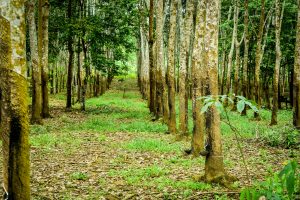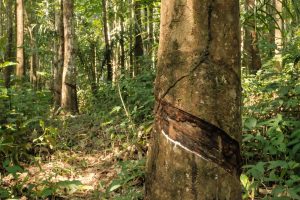
In the penultimate interview of this initial series, we hear from Marthe Tollenaar and MaryKate Bullen of New Forests, an Australia-based fund management company with more than A$5 billion invested in sustainable leading-edge forestry, land management, and conservation projects in the Asia-Pacific region and the United States.
Marthe is responsible for the environmental and social management of investments in Southeast Asia and for supporting compliance with International Finance Corporation (IFC) Performance Standards and Forest Stewardship Council (FSC) certification.

MaryKate leads corporate communications and media relations, as well as strategic planning and implementation of corporate sustainability and responsible investment initiatives. They share many decades of experience on how to make investments more inclusive.
This interview complements our previous interviews held with non-governmental organizations (the International Institute for Environment and Development and the Finance Alliance for Sustainable Trade), intergovernmental bodies (the United Nations Forum on Forests), a community organization (the Association of Forest Communities of the Peten), a development bank (the Netherlands Development Finance Company) and another investment company (FORM International), thereby enriching the discussion on inclusive finance.
How do you define ‘inclusiveness’ and why should it be addressed by financial institutions?
At New Forests, we consider inclusiveness to mean the generation of value for all stakeholders in our business, including investors and communities, and the environment. We believe that an inclusive approach ensures steadier and more long-term profitability, and creates opportunities through shared value business strategies.

We also feel that demonstrating successful business models that incorporate environmental and social benefits are essential for transitioning the forest and land use sectors to long-term sustainable models that promote equity and inclusion.
New Forests ensure that our investments use appropriate best practice in stakeholder engagement, guaranteeing inclusiveness with respect to gender, indigenous peoples, and other potentially vulnerable groups.
As global demand for resources grows, there is a need to increase productivity while ensuring the conservation of the world’s remaining natural forests and sustaining the needs of local communities. The Sustainable Landscape Investment (SLI) framework has six core themes that we apply throughout our investment portfolio, which is designed to balance these interests and deliver enhanced investment performance in support of our corporate purpose.
New Forests’ Sustainability Working Group developed a series of quantifiable measures to track our performance against each of the six themes defined in the SLI framework, and both the Shared Prosperity and Land Use themes measure the inclusiveness of our investments.
We are continuing to build on this and look to deepen the benefits that inclusiveness can bring, continuing to focus on key areas including gender, shared values, and the social license to operate (for example ensuring that Free, Prior, Informed Consent (FPIC) or similar procedures have been implemented by investees).
Read also: More dialogue needed between farmers, forest enterprises and finance providers
What are the structural barriers to financing smallholders and small- and medium-sized enterprises (SMEs)?
There are several options for New Forests to invest in smallholder forestry: The first is direct investment in smallholder-managed forestry assets through a cooperative or other organizational structure. The second is through outgrower schemes that enhance scale and production by integrating contract farmers in the business model, enhancing scale and production of our investments. A third is with forestry and agroforestry programmes, though the signing of agreements with communities for mixed cropping models either inside or outside the forest area under our management.
Structural barriers differ in each of these different investment options. Smallholder-managed forestry assets, even when they are united through a cooperative or other form of association, often lack the scale required to make an attractive business case for direct investments.

Good governance is key to meeting our strict performance and compliance requirements, but is often challenging in smallholder forestry. Organizational structures are also often lacking or poorly managed, with a high risk of internal disputes, and low smallholder commitment reduces the quality of production.
New Forests requires certification of our investments as part of our Social and Environmental Management System. The challenges described above and complex supply chains mean that there are considerable barriers to group certification, increasing reputational risk for the investor. Another challenge in the forestry sector is the long investment horizon. Smallholders are often looking for quick returns and lack the resources to make long-term investments.
Expected returns in forestry may also not be high enough for the farmers to compete with alternative crops like oil palm or annual food crops. Land tenure and land governance issues can also be barriers to investing in smallholders, because investment criteria require certainty over forestry use rights through the duration of the investment.
What are the underlying reasons for these structural barriers?
There is a clear knowledge gap at the local level of production techniques in forestry. Smallholder timber production is typically geared toward the local market, with low-tech processing facilities, and the low quality of timber products often not suited for more commercial and industrial end uses. Smallholders also traditionally lack access to the technical knowledge and expertise in improved silvicultural practices.
There is often a lack of funding for research and development and technical capacity to develop and implement appropriate Standard Operating Procedures. These aspects mean that smallholder forestry is often less productive, less efficient and less profitable than larger-scale models where such resources are available.
Smallholders also face challenges marketing their products. A lack of knowledge on pricing and markets often causes them to sell their products (far) below market-price to middlemen or processing facilities. Long, non-transparent supply chains in smallholder operations increase the marketing complexity, and corruption can contribute to unfair pricing of smallholder products.
Governance of smallholder cooperatives may lack structure and effective oversight and controls, but this may also be complicated by existing disputes or political interference, enhanced by corruption and lack of law enforcement. Communities often lack the knowledge and experience to establish formal bodies, especially with respect to finance, administration and legality.
These barriers can, however, be mitigated to some extent through capacity development, technology transfer, and development of more effective intermediaries and support organizations.
Read also: Financial products should be adjusted to better meet needs of community forest enterprises
How is your organization addressing the needs of smallholders and SMEs for finance, and what have you learnt from that?
New Forests is not focused on investing in SMEs and smallholders directly, but we seek to help our investees – which in Asia are typically medium-sized businesses or subsidiaries of larger conglomerates – identify and understand their impacts on SMEs and smallholders in order to seek where shared value opportunities may exist.

We have developed and implemented various smallholder models in our existing portfolio in Southeast Asia. In our experience, these models play an important role in creating a shared interest in our investments, facilitating shared revenue streams, and providing a social license to operate on the land. New Forests is therefore optimistic that our future investments in the region will continue to include smallholder and SME opportunities.
In addition to these integrated smallholder models, the Tropical Asia Forest Fund (TAFF), managed by New Forests, has in its portfolio companies that invest in local business development, including contract managers, handicrafts, food processing, tailors and farming businesses. Where possible, we link these development opportunities to company needs. In our Indonesian investment for example, we trained local tailors to manufacture uniforms for company staff.
We further incentivize involvement at the local level through community-based monitoring programmes. Communities in and around the forest management units are hired to monitor and patrol the forest close to their village, and receive a bonus for good management, e.g. no fires, no illegal activities, no littering.
Through smallholder models, local business development, employment and other community-based activities, New Forests’ investments promote economic development in the region, and further enhance a shared interest in the company.
What examples do you have of successful or promising financial innovations that contribute to sustainable landscapes?
New Forests has developed an innovative blended finance structure for its latest investment fund for Southeast Asia, with the goal of enhancing investment in sustainable plantation forestry and generating significant positive climate, community, and biodiversity impacts. The fund aims to bring together complementary mainstream and high-impact, development-oriented capital to invest in a diversified portfolio of plantation assets with associated impact activities.
One interesting financial innovation that we came across recently is Fast Track Trade, a platform that connects buyers and sellers through block chain technology, currently being piloted with smallholders in Indonesia.
Read also: Scaling up sustainable forestry projects key to attracting finance
What types of support and conditions are needed to ramp up development and scaling of such innovative finance?
New Forests considers that new commercial models for sustainable forestry are required to meet rising Asian timber demand while also ensuring the sustainable development of emerging markets in ways that are socially and environmentally beneficial. The impact tranche of the second phase of the Tropical Asia Forest Fund (TAFF) is an innovative step to shift capital at scale into high-impact investment models and will seek to demonstrate the case for sustainable forestry businesses in Southeast Asia. Using blended finance, the fund will focus on priority impact activities that are anticipated to support a shift in the overall risk-return profile of investments, while also targeting broader climate, community, and biodiversity benefits.
Through this, we aim to show that more sustainable investment approaches produce an overall benefit for investors, society, and the environment. By demonstrating a scalable, institutional impact investment approach, a second phase of the Tropical Asia Forest Fund (TAFF2) is positioned to be a leader that will shape the market for sustainable forestry in emerging economies. The blended finance structure may also be transferable to other regions and sectors, promoting replicability and scale for impact investment aligned to the Sustainable Development Goals and the Paris Agreement.
We believe a shift is required towards a more integrated view on finance and impact – moving from grant funding into high-impact business models. A key factor in achieving this shift is educating investors in commercial landscape investment opportunities, aligning the interests of commercial and mission-oriented finance.
By Nick Pasiecznik, Tropenbos International.
This interview has also been published on Tropenbos International’s website.
This article was produced by Tropenbos International and the Center for International Forestry Research (CIFOR) as part of the CGIAR Research Program on Forests, Trees and Agroforestry (FTA). FTA is the world’s largest research for development program to enhance the role of forests, trees and agroforestry in sustainable development and food security and to address climate change. CIFOR leads FTA in partnership with Bioversity International, CATIE, CIRAD, INBAR, ICRAF and TBI. FTA’s work is supported by the CGIAR Trust Fund.











